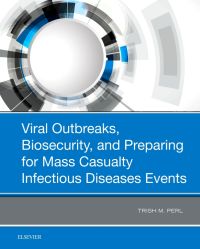Written by authorities in infectious disease and disaster preparedness, this one-stop resource covers the relevant theoretical, historical, and pragmatic considerations of viral outbreaks and bioterrorism. It provides an expert overview of this complex area for infectious disease physicians, emergency medicine physicians, hospital administrators, and more.
Key Features
- Explores the historical context of various agents and potential agents that could be used for bioterrorism, including anthrax, tularemia, smallpox, SARS, and more
- Discusses the lessons learned from naturally occurring outbreaks that have enhanced preparedness at individual hospitals locally, regionally, nationally, and internationally.
- Provides forms, checklists, and algorithms throughout – invaluable resources for health care providers and administrators
- Consolidates today’s available information on this timely topic into a single convenient resource
Author Information
By Trish M. Perl, MD, MSc, Jay P Sanford Professor of Medicine, Chief of Infectious Diseases, Division of Infectious Diseases, UT Southwestern Medical Center, Dallas, Texas, USA and Daniel Maxwell, Assistant Professor of Medicine, Infectious Diseases and Critical Care, UT Southwestern / Dallas VA Medical Center, USA
1. Perspectives on Bioterrorism and Pandemics
2. A Brief History of Biological Warfare and Bioterrorism
3. Anthrax: Ancient Surge and Current Biothreat
4. Tularemia: A Bioterrorist Threat and Public Health Concern
5. Plague: The Yersinia pestis Infection
6. Viral Hemorrhagic Fevers (VHFs): An Archetype for Risk Management and High-Consequence Pathogens
7. Smallpox and Mpox
8. Preparing for Influenza Epidemics and Pandemics
9. Avian Influenza
10. Severe Acute Respiratory Syndrome (SARS)
11. Middle East Respiratory Syndrome
12. SARS-CoV-2
13. The Age of Synthetic Biology: Changing Biosecurity Risks
14. Preparing for Viral Outbreaks and Bioterrorism: The Public Health Perspective
15. Prevention in Healthcare and Public Health
16. Surveillance Strategies
17. Infectious Diseases Transmission Dynamics, Modeling of Outbreaks, and Interventions
18. Risks and Challenges for First Responders Managing Patients Infected With or Exposed to High- Consequence Infectious Diseases
19. Healthcare Preparedness for Infectious Diseases Mass Casualty Events, Including Bioterrorism, Viral Outbreaks and Pandemics
20. Special Care Units
21. Diagnostics
22. Protecting the Frontline and Preventing Transmission of High-Consequence Agents and Other Pathogens With Pandemic Potential in Healthcare Settings
23. Vaccination: Immunology and Public Health Considerations
24. Vaccines
25. Therapeutics Overview for Agents of Bioterrorism and Viral Outbreaks
26. Ethical Issues in Preparing for and Responding to Infectious Outbreaks and Bioterror Attacks
27. Strategies for Successful Communications During Health Emergencies: Insights From Journalists Turned Public Relations Experts
28. Recovery From Biological Disasters: Bioterrorism, Outbreaks of Emerging Infectious Diseases, and Pandemics


